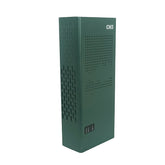The principle of operation and method of common UAV jammers
In March 2017, a US $ 3 million Allied Patriot missile launched a US $ 200 drone from Amazon. However, to buy an unmanned aircraft it costs US $ 3.4 million. Are there other anti-drone solutions? The Russian military has set up a ground force to attack enemy drones. This device is the first of its kind in Russia. It operates an electronic wifi jammer which can theoretically separate the radio link between the drone and its operator. Russian-made drone jammers have recently been successful in suppressing drones, according to reports. But that doesn't mean that the United States' huge military drone fleet lacks defensive capabilities.
Principles and methods of UAV jammers.
The unmanned aerial vehicle is radio controlled in a certain frequency range and the GPS locator is an autopilot. The anti-drone solution uses drone jammer to intercept control signals with high performance radio signals. Another solution is to hijack the flying drone via GPS or frequency control by sending spoofed signals.

skylifr.com provides anti-drone solutions. Interference with radio frequency interference from UAVs and UAVs, as well as jamming communications system between UAVs and pilots, and try to make it believe it is not in range. The anti-drone gun will not destroy or control the drone; this will only force the drone to land or return to the starting point. The drone killer helps prevent unauthorized flying robots from reaching sensitive and vulnerable areas. In order for the cell phone to prevent the program from working properly, it must be close enough to the signal that personnel will interfere with. For example, according to Australian Aerodynamics, an independent think tank dedicated to avionics systems, Avtobaza can detect targets up to 93 miles in length. Jammer requires more power than detection, so Avtobaza can jam drones with a range of less than 90 miles.
This is why Russian jammers and the new "special forces" operating their anti-drones do not necessarily present a survival risk for US military drones. Russian drone hunters can struggle to find targets. A former US drone developer who asked not to be named said: "It's hard to imagine if you'll know when and where."













